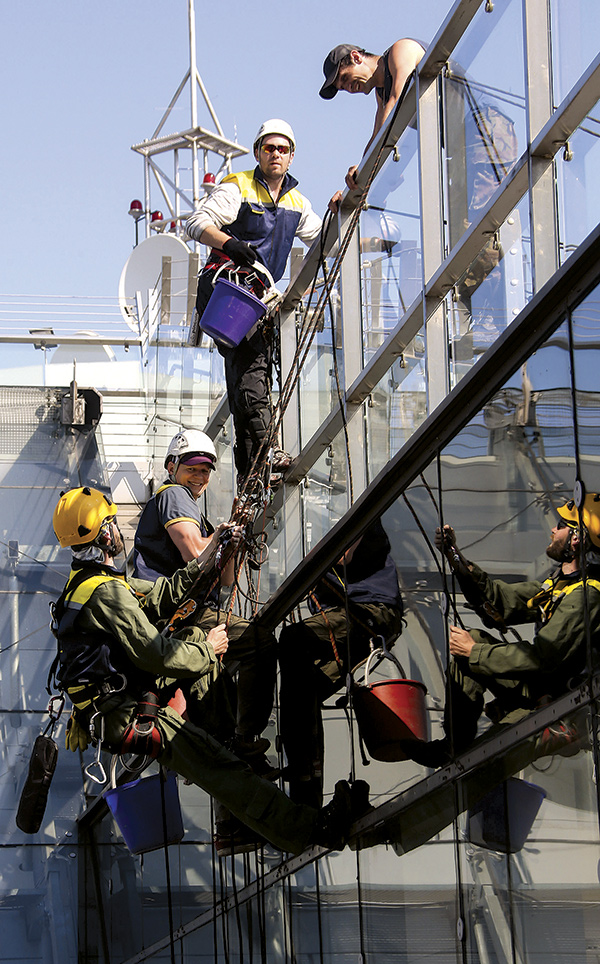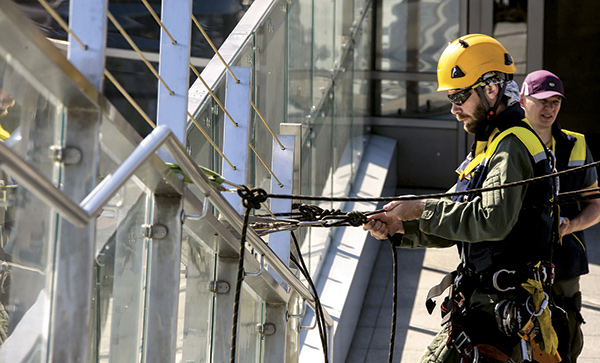
Minsk climbers have a lot to do in summer
Alexey Rys, aged 36, the foreman of a climbing cleaning team, shouts out, “I’ve reached the ‘crown’, and we’ve finished the ‘skirt’!” The stained-glass window of the library’s atrium is known as the skirt, and he is calling from the very top, speaking to his colleagues Dmitry, Sergey and Vitaly. All use nicknames, to make it easy to call out messages.
Rys tells us, “Safety is our primary concern, followed by comfort,” speaking for all steeplejacks and climbers. “We’re starting today by checking bands: the belly band and guideline, descender devices, haul-safe, carabiners and knots.”
As they rig up, wearing mountaineering helmets, I join the head of sales, Nina Radevich, from Chisty Svet Plus company, and her colleague, Dmitry Linevich. We’re on the 23rd floor of the library, at the scenic viewpoint, over 73m up. It takes your breath away to see beauty of the city. Suddenly, the team comes into view, descending slowly.
“I see this every day, but I’m still afraid for them,” Nina admits, closing her eyes. The team shrugs off such concern. Alexey laughs, “Usually, people have only three questions: are we afraid? How much are we paid? and can we swing on the bands.”
Alexey hands out buckets, rags, strainers and roller sleeves for cleaning, as well as microfiber cloths. “For cleaning surfaces, we use different tools than most cleaning teams; the library windows are protected with special film, so we use diluted soap solutions to avoid damaging this, without excess alkalinity or acidity. It’s the same method as is used in Dubai, for the Burj Khalifa Tower,” Nina explains.
Some parts of the library can’t be accessed from outside, even via mobile scaffolding and skylifts. Nina takes me where no journalist has stepped before, between the bearing wall of the library and the spider glazing system of the facade. I can’t help but feel fearful, here, within, standing in the gangway. A female team cleans in this space.
Alexey notes that he spends a lot of time on his knees, which requires endurance. Nina comments that their company cleans most of the tall buildings in Minsk but that the National Library presents the most challenges. She muses that designers don’t tend to think about how buildings will be cleaned safely when they’re making their plans: adding bars where climbing equipment can be hooked, for cleaning the facade. Instead, she notes, “Our industrial department has to work out how to reach ‘dead zones’ .” It takes three to six months for the team to complete a thorough cleaning of the National Library building, working every day, regardless of wind, rain, fog, heat or frost.

Nina notes that it takes a certain frame of mind to become a professional climbing cleaner. Besides being fit and unafraid of heights, you need a diploma in industrial mountaineering and high-rise works. She believes that experience, a clear mind and sharp reflexes are important too. The team underlines the need for a certain serious attitude. Rys tells us, “No matter how you look at it, we fear heights, as is logical. In fact, you need to retain this caution, to remain careful and responsible.”
Alexey knows about danger first-hand, having fallen several times in his climbing career. The first was from a height of 7m, which broke his heel. When he fell from the third floor, he got off with only a scare. “I fell through stupidity, failing to think seriously about safety,” he explains. “I was young, so did not feel fear.”
Everyone on the cheerful team has completed higher education. There’s a former teacher of physical training, a civil engineer, a coach, and a policeman. Each passed specialised training, involving theory and practice. They’re full of jokes, which they explain may be a side-effect of the dangerous element of their job. As to the enjoyment they gain for their work, they laugh, “We like it so much that we’re climbing the walls.”
The foreman notes that while it takes only a fortnight to become a ’Monkey’, able to climb and descend, it takes at least 3-4 years to become a professional able to navigate any object. Naturally, the team is most busy in the summer, while February and March are quiet. In the winter, they tend to just remove snow and ice.
Nina Radevich adds, “In the past, only builders tended to employ industrial mountaineering teams but, with the appearance of new high-rise buildings, made from glass and metal, climbers have begun to enjoy popularity.”
Saying goodbye, I ask Alexey whether he’ll be sunbathing this summer. He admits that there’s too much work to do for that, although he may find time to go to the mountains. He speaks with horror of the idea of parachuting though. Even the bravest have their fears.
By Anna Kisel











